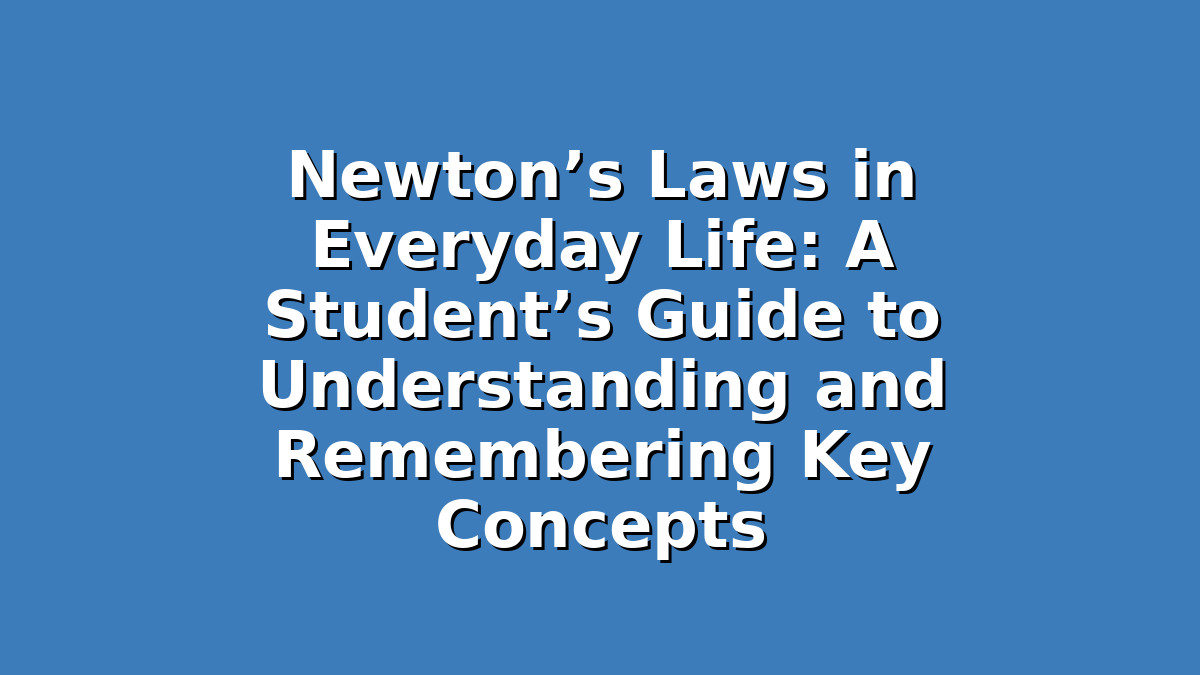If you’re a student preparing for exams or looking to deepen your understanding of physics, mastering Newton’s Laws of Motion is essential. These fundamental principles explain how objects move and interact, and they’re not just abstract concepts found in textbooks—they play out all around us every day. In this article, we’ll explore Newton’s three laws of motion through examples from everyday life, offer practical study tips, and provide strategies to help you remember and apply these concepts confidently in your exams.
Understanding Newton’s First Law: The Law of Inertia in Study and Life
Newton’s First Law states: *An object at rest stays at rest, and an object in motion stays in motion with the same speed and in the same direction unless acted upon by an unbalanced force.* This is often called the law of inertia, which means objects resist changes in their state of motion.
Everyday Example:
Imagine a book lying on your desk. It won’t move unless you push it. Similarly, if you slide a hockey puck on ice, it keeps moving until friction or another force slows it down.
How This Helps You Study:
When it comes to studying, think about your own inertia. Just like objects, you might find it hard to start studying after a break or a long day. Recognizing this “inertia” can help you plan better. Begin your study session with a small, manageable task (like reviewing one flashcard or one question) to overcome the initial resistance. Once you’re “in motion,” it becomes easier to keep going.
Study Tip:
Create a study ritual to initiate your “motion.” For example, always start with a 5-minute review of what you learned the previous day. This consistent routine helps you build momentum and beat procrastination by mimicking the concept of inertia.
Exploring Newton’s Second Law: The Relationship Between Force, Mass, and Acceleration
Newton’s Second Law states: *The acceleration of an object depends on the net force acting upon it and inversely on its mass.* The law is often written as the equation F = ma (Force equals mass times acceleration).
Everyday Example:
Think about pushing a shopping cart. When the cart is empty, it’s easy to push (small mass, so less force is needed for acceleration). When it’s full of groceries, it’s heavier, and you need to apply more force to move it at the same speed.
How This Helps You Study:
In your studies, “force” can be thought of as your effort, “mass” as the difficulty or amount of material, and “acceleration” as your progress or improvement.
– If you try to learn a large amount of difficult content (“mass”), you need to increase your “force” (study time, focus, and energy) to make good progress.
– Conversely, if the material is lighter or easier, less effort is needed for the same improvement.
Study Tip:
Break down large topics into smaller, manageable chunks to reduce the “mass” you’re trying to accelerate. Use active learning techniques like practice questions or teaching the material to a friend. This targeted “force” helps you accelerate your learning efficiently.
Additional Tip:
Track your study sessions and results. If you notice you’re not making progress despite your effort, it might mean you need to adjust your methods—either increase your “force” by changing study techniques or reduce the “mass” by focusing on key concepts.
Applying Newton’s Third Law: Action and Reaction in Your Study Environment
Newton’s Third Law states: *For every action, there is an equal and opposite reaction.* This means forces always come in pairs; when you push on something, it pushes back on you.
Everyday Example:
When you jump off a boat onto a dock, the boat pushes back and moves slightly away from the dock. Or, when you walk, your foot pushes against the ground, and the ground pushes back, propelling you forward.
How This Helps You Study:
Understanding this law can remind you about the feedback loop inherent in studying. When you put in effort (the “action”), you should expect a reaction or result (improved knowledge, better grades).
– Positive reaction: When you prepare well, you perform better.
– Negative reaction: If you neglect studying, your results might suffer.
Study Tip:
Seek feedback regularly. Take quizzes, ask teachers or peers for input, and reflect on your mistakes. This “reaction” helps you adjust your “action” (study techniques) to improve.
Additional Tip:
Remember that learning is a two-way process. Just as physical forces interact, your study habits and results influence each other. When you encounter difficulties, don’t get discouraged—use the feedback as a push to adjust your approach.
Conclusion: Bringing Newton’s Laws Into Your Study Life
Newton’s Laws aren’t just principles for physics problems; they offer useful metaphors and practical insights for your study habits and daily life. The law of inertia reminds you to get started and build momentum, the second law teaches the importance of effort relative to challenge, and the third law emphasizes the value of feedback and adjustment.
As you prepare for your exams, try to visualize each law with everyday examples and relate them to your study routine. Use the study tips provided to turn these concepts into effective strategies. Remember, consistent effort and smart study techniques can create powerful “forces” that accelerate your learning and help you achieve your academic goals.
Keep pushing forward, stay curious, and let Newton’s Laws inspire not just your physics knowledge but your entire approach to learning!
—

Responses